|
|
|
35th Searchlight Regiment, Royal Artillery
35th (1st Surrey Rifles) Searchlight Regiment, Royal Artillery was a Territorial unit formed in August 1940 by the redesignation of 35th (1st Surrey Rifles) Anti-Aircraft Battalion, Royal Engineers. They served in the UK throughout the Second World War.
If you can provide any additional information, especially on actions and locations at specific dates, please add it here.
|
|
|
The Wartime Memories Project is the original WW1 and WW2 commemoration website.
Announcements

- 1st of September 2024 marks 25 years since the launch of the Wartime Memories Project. Thanks to everyone who has supported us over this time.
- The Wartime Memories Project has been running for 25 years. If you would like to support us, a donation, no matter how small, would be much appreciated, annually we need to raise enough funds to pay for our web hosting and admin or this site will vanish from the web.
- 18th Dec 2024 - Please note we currently have a huge backlog of submitted material, our volunteers are working through this as quickly as possible and all names, stories and photos will be added to the site. If you have already submitted a story to the site and your UID reference number is higher than
265120 your information is still in the queue, please do not resubmit, we are working through them as quickly as possible.
- Looking for help with Family History Research?
Please read our Family History FAQs
- The free to access section of The Wartime Memories Project website is run by volunteers and funded by donations from our visitors. If the information here has been helpful or you have enjoyed reaching the stories please conside making a donation, no matter how small, would be much appreciated, annually we need to raise enough funds to pay for our web hosting or this site will vanish from the web.
If you enjoy this site
please consider making a donation.
Want to find out more about your relative's service? Want to know what life was like during the War? Our
Library contains an ever growing number diary entries, personal letters and other documents, most transcribed into plain text. |
|
Wanted: Digital copies of Group photographs, Scrapbooks, Autograph books, photo albums, newspaper clippings, letters, postcards and ephemera relating to WW2. We would like to obtain digital copies of any documents or photographs relating to WW2 you may have at home. If you have any unwanted
photographs, documents or items from the First or Second World War, please do not destroy them.
The Wartime Memories Project will give them a good home and ensure that they are used for educational purposes. Please get in touch for the postal address, do not sent them to our PO Box as packages are not accepted.
World War 1 One ww1 wwII second 1939 1945 battalion
Did you know? We also have a section on The Great War. and a
Timecapsule to preserve stories from other conflicts for future generations.
|
|
Want to know more about 35th Searchlight Regiment, Royal Artillery ? There are:431 items tagged 35th Searchlight Regiment, Royal Artillery available in our Library There are:431 items tagged 35th Searchlight Regiment, Royal Artillery available in our Library 
These include information on officers, regimental histories, letters, diary entries, personal accounts and information about actions during the Second World War. |
|
S/Sgt. Roland Neville Giddens Warburton Glider Pilot Regiment  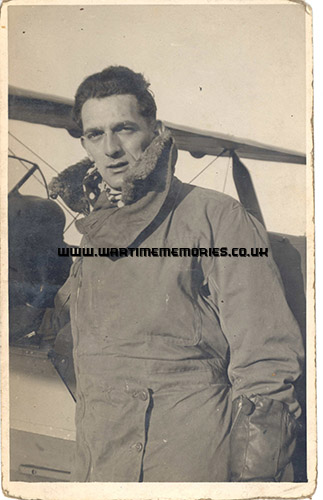 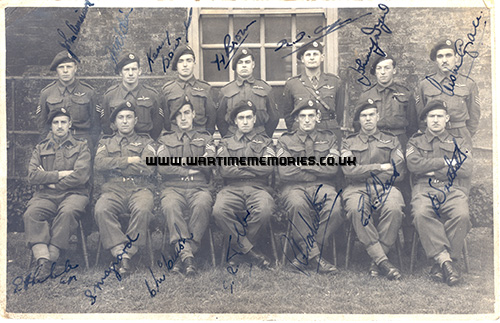 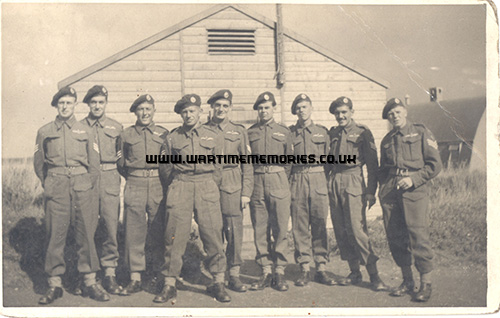  Roland Warburton joined up, somewhat reluctantly on 16th of October 1939. He had been working towards Civil Service Examinations and applied for exemption from call-up due to studies, but when all Civil Service exams were cancelled until further notice, he had to accept the call-up papers.
He was initially sent to 216th Searchlight Training Regiment R.E. On completion of the training he was posted to as a Gunner to 37th AA Battalion R.E. on 15th of January 1940.
In March of that year, he was granted leave and returned home to marry, a marriage that lasted 60 years, until his wife's death in the autumn of 2000. At that same time his Regiment came under the Royal Artillery, becoming 37th Tyne Electrical Engineers S/L Regiment, a Territorial Army unit.
As part of 307th Battery of that regiment, he embarked for France 18th of May 1940 landing at and deploying to protect the port of Le Havre. They were soon cut off from the remnants of the British Expeditionary Force that were being evacuated from Dunkirk and had to make their way westwards, eventually taking a ship from St Malo, arriving back in England 19th of June 1940.
After a period of leave he was sent to a training Battery attached to 37th S/L Regiment R.A. 28th July and promoted to Bombardier the next day. He was designated as Acting War Substantive Bombardier on 1st October, the promotion being confirmed at the turn of the year. On the 15th October he transferred to 519 Battery, 222nd S/L Training Regiment R.A. in the Taunton area where he remained until 5th of March 1942 when he volunteered to serve in the recently formed Glider Pilot Regiment.
Initial training was at Tilshead, on Salisbury Plain, before moving to 16 Elementary Flying Training School at Burnaston, Derbyshire at the beginning of May, where he learned to fly on Miles Magister aircraft. He completed his first solo flight a month later and passed out from 16 E.F.T.S. by the middle of July and was promoted to Sergeant, in line with G.P.R. requirements.
From there he went to No.1 Glider Training School at Thame, Oxfordshire, to fly the Hotspur glider. He graduated to the Operational Training Unit at the end of August and then to the Heavy Glider Conversion Unit at Brize Norton in mid-October to fly the much larger Horsa glider. December had him move to the Glider Pilot Exercise Unit before being posted to the 2nd Battalion of the Glider Pilot Regiment 3rd of March 1943.
A month later they embarked at Greenock for North Africa, landing at Oran, Algeria, 23rd of April 1943. During the sea voyage, they were re-designated as 2 Squadron G.P.R. as part of the 1st Airborne Division. There was a complete lack of gliders, but U.S.A. supplied a number of crated Waco CG.4 gliders, which some of the squadron helped to assemble.
After a few training flights, they were towed eastwards on a four-and-a-half-hour flight over the Atlas Mountains to their forward base in Tunisia at the end of June.
From here, on the night of 9th July, Operation Ladroke was launched to invade Sicily. His Waco carried half a platoon of the South Staffordshire Regiment who were tasked with neutralising several Italian gun positions and then capturing Ponte Grande on the approach to Syracuse.
He was fortunate in having a committed American pilot in the C-47 Skytrain aircraft that towed him to the designated release point, despite strong winds across the Mediterranean and some flak from the shore. He therefore landed about a mile short of the planned Landing Zone and his troops were able to carry out some of their tasks. Compared to the overall statistics of this operation, it was a notable achievement. Within a few days, the Glider Pilots were all evacuated by sea back to Tunisia and then moved on to Libya.
Two months after his first operation, he was back in action again during Operation Slapstick, a seaborne landing at Taranto on the Italian mainland on 9th September.
This time, he had to take the role of an infantry soldier as per the G.P.R. total soldier concept. The landing was unopposed, so there was no real fighting.
He told a story of a motorcycle accident at which he was presumed dead and was laid out in the morgue. Much to the medical orderly's surprise, he revived in the cool and sat up!
Probably as a result of this he was suspended from flying for medical reasons. He was returned to the rank of W/Cpl, although was permitted to continue wearing the Army Flying Badge.
At his own request, he transferred back to a Royal Artillery Searchlight unit, initially joining 422nd S/L Battery as from 3rd of September 1943 and participated in the gradual northwards advance of the 8th Army through Italy.
Maybe the motor cycle accident actually occurred in March 1944, as he was posted to the X(4) List on 3rd March and there is a gap in his service records for 5 months, but he remained in Italy until he was taken on strength of 323rd Independent Searchlight Battery on 7th of August 1944.
A whole year later, after the end of the War, the next entry on his service record shows him attending a 3-week course at an Army School in Perugia on 19th of August 1945, after which he was appointed as an Education Sergeant with the Central Mediterranean Force.
He talked about working with street children in Naples and also being sent to Klagenfurt in Austria to help with the processing and release of German & Italian POWs, but his service record shows no evidence of this.
He was finally sent home across Europe by train in January 1946 where he was reunited with his wife and demobilised, having earned the Defence Medal, the Africa Star and the Italy Star.
He went on to train as a teacher at Padgate College, near Warrington and spent the rest of his life teaching or as a Tutor Youth Officer. They had two children, but sadly the first was stillborn in 1946. They moved to Hertfordshire in 1955 where he lived until his death just before Christmas 2001.
He made a hobby of photography and was well respected in amateur photographic circles.
|
Sgt. Ida Emily Belfield 35th Searchlight Regiment, 342nd Bty. Royal Artillery My mother Ida Belfield was an ATS Sergeant in the 35th Searchlight Regiment, 342nd Battery, Royal Artillery in WW2. I would love to trace her story.
|
Pte. Ronald Robert Broadway 35th Searchlight Regiment, 342nd Battery Royal Artillery  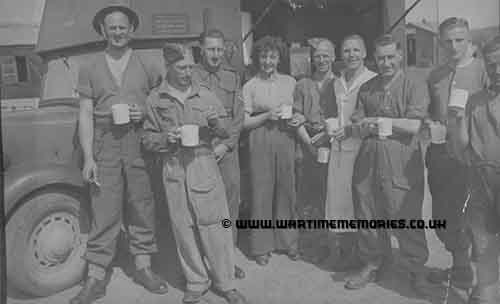 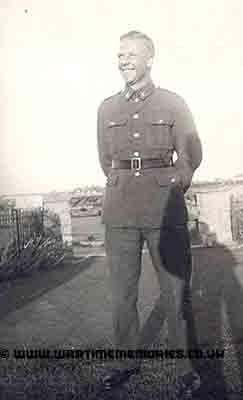 On the 18th of April 1939, Ron Broadway, my Dad, enlists in the Territorial Army, Royal Engineers. He signs up for 4 years. His Attestation (enlistment) took place at Highwood Barracks, Lordship Lane, Dulwich. He was declared fit and assigned to 342 AA Company, 35th AA Battalion RE (TA).
At the time of enlistment Dad was: 25 years and 8 months. He stood 5’ 6” tall, weighed 145lbs, his girth when fully expanded was 38.5”. He was of fresh complexion with blue eyes and fair hair. He was assigned as Sapper R R Broadway No. 2085852. His address at the time was given as 37 Playdell Avenue, Stockwell, SE19 and he was a Decorator by Trade.
Highwood Barracks was so named from the Dulwich Volunteers who fought in WW1 at Highwood on the Somme. Although the Barracks no longer exist a block of flats built there in recent years bears the name Highwood.
Home to 35th (First Surrey Rifles) Anti-Aircraft Battalion, Royal Engineers (H.Q., 340th, 341st, 342nd & 343rd Anti-Aircraft Companies, Royal Engineers) The 21st Bn. The London Regiment was also converted into a searchlight unit of the Royal Engineers in 1935. It was affiliated to the East Surrey Regiment. The headquarters and all the companies were based at 4, Flodden Road, Camberwell, London.
In January 1940 it was redesignated as the 35th Searchlight Regiment, Royal Artillery.
In March 1942, it was converted into the 129th Light Anti-Aircraft Regiment, Royal Artillery. The regiment served in the U.K. throughout the war.
On the 18th of June 1939 Dad was embodied (put on stand by) into the Regular Army. As Dad was in the TA his unit was embodied into the Army and prepared for duty in the UK. As a member of the TA he was not expected to serve abroad, but could volunteer for overseas service. On the 16th of July 1939 his unit was Disembodied (stood down) from the Regular Army
the TA volunteers would have returned to their normal peacetime occupations.
On the 19th of August 1939 he married Dorothy Margaret Archer and on the 24th of August he was called out for actual Military Service and Reported to TA Barracks in Dulwich before being posted to 342nd Battery, 35th Searchlight Regiment at Wingham in Kent. On the
1st of September the 342nd/35 S/L Battery was embodied into British Army
on the 3rd of September 1939 at 11.15am War declared with Germany
On the 1st of August 1940 Dad Transferred to Wingham in Kent with the 342/ 35th Searchlight Regt., Royal Artillery, having mustered as a Gunner
On the 21st of August 1940 hereported sick on leave and failed to return to Wingham on expiration of his pass. On the 3rd of September he returned from sickness on leave to Wingham.
18th November 1940: 342nd S/L Battery vacated DG area, being relieved by 314th S/L Batt. The personnel concentrated at Herne Bay and billeted in town overnight. The following day the Battery moved by train to Seaton, Devon and were accommodated at Warner’s Holiday Camp, Seaton.
1st to 26th December 1940 was a period spent on squad drilling, PT, arms drill and route marches. In addition much entertainment during period as well including boxing tournaments, football and rugby matches against other units. On the
8th of December 1940 a Defence exercise was held against local Home Guard
and on the 19th a warning order was received notifying movement to Leatherhead, this was confirmed on the 21st and on 27th December they moved by rail to Leatherhead to replace 460th S/L Battery
On the 10th of February 1941 Dad was admitted CBS Fetcham (this would have been through an injury received. CBS Fetcham was probably a casualty clearing station) He was discharged on the 18th.
On the 28th of May 1941 Dad was Classified as Class 2 (Non tradesman) Cook at Leatherhead. 342/35 S/L Regt. In July the Battery moved to Herstmonseux and in August to Storrington. On the 5th of September the Battery moved to Funtington Hall Hotel, Chichester then on the 24th
to Midgley Lodge, Farnborough.
On the 28 March 1942 Dad was upgraded from Class 2 to Class 1 Non-tradesman cook wghilst stationed in Watford with 342/79 S/L Regt.
On the 31st of May 1942 he became attached to London District School of Cookery from 31 May to 13 June. He undertook a Course of Kitchen Management, Organisation and Technical Control and achieved a pass rate of 88%. On the 25th of August 1942 he was Posted to 342(M) S/L Battery R.A. at Watford then on the 9th of December was Posted to 79th S/L Regt. RA Watford abd on the 11 December to 502 S/L Battery RA Field. On the
11th of February 1943 he transferred to the Army Catering Corp in the rank of Pte. as non-tradesman Class 1. Permanently attached to 79 S/L Regt. R.A.
On the 29 May 1943 Dad Tested and Classified Gp. B Class 2 Tradesman Cook by Officer Commanding 502 S/L Bty. RA. On the 22nd of April 1945 he was Taken on Strength of Admin Battalion, Army Catering Corp, Training Command
until the 20th of May when he embarked for the Middle East, arriving on the 3rd of June 1945 where he was posted to Army Catering Corp. On the
10th of July 1945 Dad was posted to 922 Company RASC and on the 26th was appointed Acting Corporal. He seems to have suffered an accident on the
12 September 1945 and on the 4th of October he was admitted to 27 General Hospital, being relegated to Private on admission to hospital. He was discharged and returned tohis unit on the 17th of October.
I have his notification of impending release form dated 19th October 1945: Pte. Ronald Robert Broadway No. 2085852 of 922 Company Army Catering Corp (Cook Gp. 8 Class2). Military Conduct: Exemplary. Testimonial: Has proved himself a willing worker and has applied himself with zeal to his duties and carried them out efficiently, sober and well behaved. A sound reliable man with good organising ability.
On the 20th of October 1945 Dad was Posted to X List, Sidi Bashr, Egypt (The X list was the register of those personnel awaiting repatriation and discharge to the UK and on the 25th was released for embarkation to UK.
He was released to Territorial Army Reserves on 31st December 1945.
|
Recomended Reading.Available at discounted prices.
|
|
|














